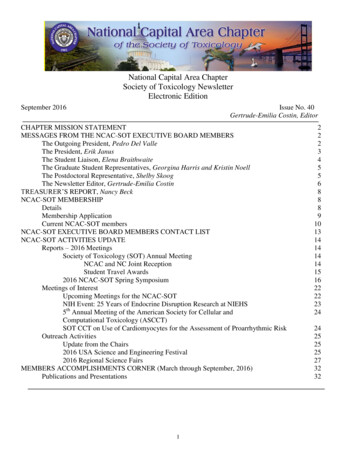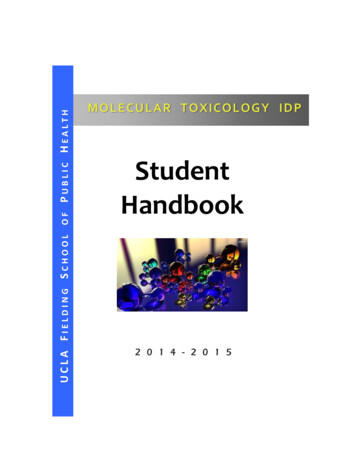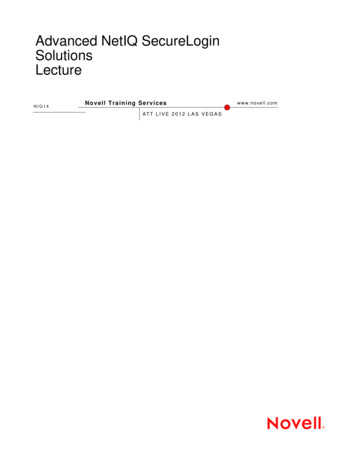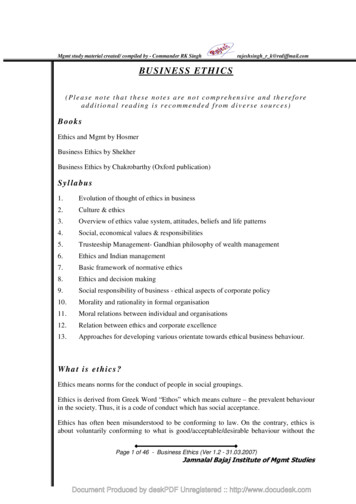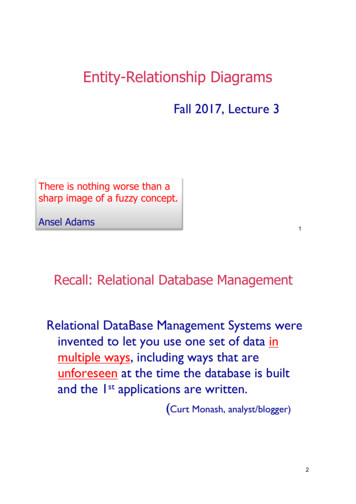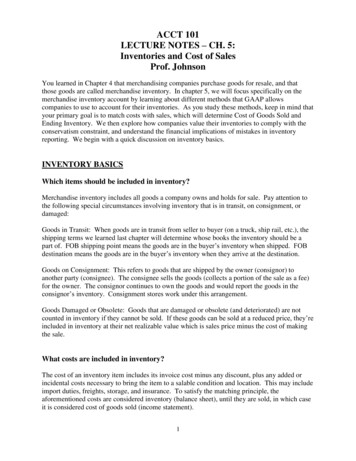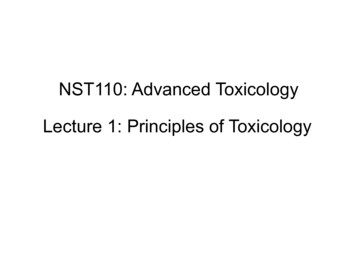
Transcription
NST110: Advanced ToxicologyLecture 1: Principles of Toxicology
Principles of Toxicity1. Defining toxicology2. History of toxicology3. Dose response4. Evaluating safety
ToxicologyToxicology is the study of adverse effects of chemicals onliving systems, including: Mechanisms of action and exposure to chemicals as a cause ofacute and chronic illness. Understanding physiology and pharmacology by using toxic agentsas chemical probes. Recognition, identification, quantification of hazards fromoccupational exposure to chemicals. Discovery of new drugs and pesticides. Development of standards and regulations to protect humans andthe environment from adverse effects of chemicals.
Branches of Toxicology1. Mechanistic—cellular, biochemical andmolecular mechanisms by whichchemicals cause toxic responses2. Forensic—cause of death, legal aspects3. Clinical—treatments for poisonings andinjuries caused by xenobiotics4. Environmental—environmentalpollutants, effects on flora and fauna5. Food—adverse effects of processed ornatural food components6. Regulatory—assigns risk to substancesof commercial importance.
Origins of Toxicology Earliest humans used animal venoms and plant extractsfor hunting, warfare and assassination. 400 BC: Hippocrates compiled a listing of a number ofpoisons and outlined some clinical toxicology principles. 1493-1541: Paracelsus—physician and philosopher All substances are poisons; the right dosedifferentiates a poisons from a remedy. “Dose determines toxicity.” 1775: Percival Pott found that soot caused scrotalcancer in chimney sweeps. Much later the carcinogens insoot found to be polycyclic aromatic hydrocarbons. 1972: Rachel Carson/EPA led to ban of insecticide DDTfor environmental and health concerns
Examples of Toxicological Cases 399 B.C. Socrates, a Greek Philosopher died ofHemlock poisoning (according to Plato) Coniine is the active toxic ingredient Antagonist for the nicotinic acetylcholinereceptor, leading to cessation ofneurotransmission, muscular andrespiratory collapse and deathconiine October 20th, 1740 Charles VI, Holy RomanEmperor, King of Bohemia, Hungary, andCroatia died from eating death cap mushrooms Active ingredient is alpha-amanitin thatinhibits RNA polymerase inhibiting proteinsynthesis leading to hepatocellular lysis,liver failure, kidney failure, coma,respiratory failure, and deathAlpha-amanitin
Examples of Toxicological Cases April 30th, 1945, Eva Braun, long-timecompanion of Hitler committed suicide with acyanide capsule Inhibitor of cytochrome c oxidase, part ofcomplex IV of the electron transport chainand inhibits ATP production leading to braindeath and heart cessation, hypoxia, anddeathJan 16th, 1975 Bando Mitsugoro VIII, a famousJapanese Kabuki actor died from eating 4 liversof pufferfish Active toxic ingredient is tetrodotoxin Tetrodotoxin blocks voltage-gated sodiumchannels leading to suppression ofneurotransmission, numbness,bronchospasms, coma, respiratory failure,deathtetrodotoxin
Examples of Toxicological Cases 1932-1968: Minamata disaster—caused by methylmercurytoxicity from industrial wastewater from ChissoCorporation in Minamata City in Japan 2265 victims Caused neurological syndrome associated withmethyl mercury poisoning including ataxia, numbness,insanity, muscle weakness, hearing and speech loss,birth defects, paralysis, coma, death Alters neurochemistry and neurotransmission throughmultiple mechanisms1988, Saddam Hussein used sarin on Kurds, 1995,Japanese subway sarin attack by terrorist group; 2006 day5 of “24”—Jack Bauer saves LA from VX attack in TVshow; 2013 Assad uses sarin against rebels Sarin and VX are an organophosphorus chemicalwarfare agents that inhibits acetylcholinesterase,leading to excess acetylcholine and hyperstimulationof neurons, resulting in seizures, tremoring,convulsions, excess salivation, excess tearing,urination, defecation, bronchoconstriction, respiratoryfailure, deathMethyl mercurysarin
Dose-ResponseIndividual dose-response% response% maximalresponseResponse of an individual organism to varying doses of a chemical (also called“graded” response because effect is continuous over a dose range) (e.g.enzyme activity, blood pressure).Y-axis: % of max. response(linear in middle range)100X-axis: dose (e.g. mg/kg or molarconcentration) (plotted as logbase 10)80A60Can derive lethal dose (LD50),toxic dose (TD50), effective dose(ED50) values from doseresponse data.40B20010-1100101102dose, mg/kg103104Inhibitory concentration (IC50)can also be determined fromconcentration-response curves.
Dose-Response Curves for Beneficial Substancestoxicitydeaththreshold foradverse responseresponseregion ofhomeostasisdeficiencytoxicitydose For substances required for normal physiological function andsurvival, the dose-response curves will be U- or J-shaped. At very low doses, there is an adverse effect (deficiency), whichdecreases with increasing dose (homeostasis). At very highdoses, an adverse response appears from toxicity. For example, vitamin A can cause liver toxicity and birth defectsat high doses and vitamin A deficiency is lethal.
Evaluating Dose-Response RelationshipsED: Effective dose% response100806040(therapeutic dose of a drug)50 %responseTD: Toxic doseED(dose at which toxicity occurs)TDNOAEL LOAELLD20LD: Lethal dose(dose at which death occurs)NOAEL: no observed adverse effect levelLOAEL: lowest observed adverse effect0level-2-1012310 10 10 10 10 10dose (mg/kg)ED50: dose at which 50% of population therapeutically responds.(In this example, ED50 1 mg/kg)TD50: dose at which 50% of population experiences toxicity (TD50 10 mg/kg).LD50: dose at which 50% of population dies (LD50 100 mg/kg).
Comparing Toxicity of CompoundsTherapeutic Index (TI)TI LD50/ED50orTI TD50/ED50 TI is the ratio of the doses of the toxic and the desiredresponses. TI is used as an index of comparative toxicity of two differentmaterials; approximate statement of the relative safety of adrug. The larger the ratio, the greater the relative safety.
Example of using TI to compare relativesafety of 2 drugs.8080ED60TD40200-5-4-3-2-1012310 10 10 10 10 10 10 10 10 10drug A dose (mg/kg)4% response% reponse% effect100% effect10060ED40TD20010-5 10-4 10-3 10-2 10-1 100 101 102 103 104drug B dose (mg/kg)Drug A: TI TD50/ED50 100/0.01 10000Drug B: TI TD50/ED50 1/0.01 100Which drug is safer?
Disadvantages of Using TI% response% effect10099 % responseLDAEDA and B8060LDB4020010-350 % response1 % response10-210-1100101102103dose (mg/kg)Drug A: ED50 2 mg/kg; LD50 100 mg/kgDrug B: ED50 2 mg/kg; LD50 100 mg/kgDrugs A and B both have the same TI 100/2 50Therapeutic index does not take into account the slopeof the dose-response curves.
Margin of Safety% response% effect10099 % responseLDAEDA and B8060LDB4020010-350 % response1 % response10-210-1100101102103dose (mg/kg)Margin of safety can overcome this deficiency by using ED99 forthe desired effect and LD1 for the undesired effect.Margin of safety LD1/ED99Drug A: LD1/ED99 10 / 10 1Drug B: LD1/ED99 0.002 / 10 0.0002Thus, Drug B is much less safe than Drug A.
Toxic PotencyAgentLD50 (mg/kg)Ethyl alcohol10,000Sodium chloride4,000BHA/BHT (antioxidants)2,000Morphine sulfate900Caffeine200Nicotine1Curare0.5Shellfish toxin0.01sarin0.001Botulinum toxin0.00001slightmoderatehighExtremely high( 1 mg/kg)
ED TD LD 50 % response % response NOAEL LOAEL. Comparing Toxicity of Compounds Therapeutic Index (TI) TI LD 50/ED 50 or TI TD 50/ED 50 TI is the ratio of the doses of the toxic and the desired responses. TI is used as an index of comparative toxicity of two different materials; approximate statement of the relative safety of a drug. The larger the ratio, the greater the relative .
